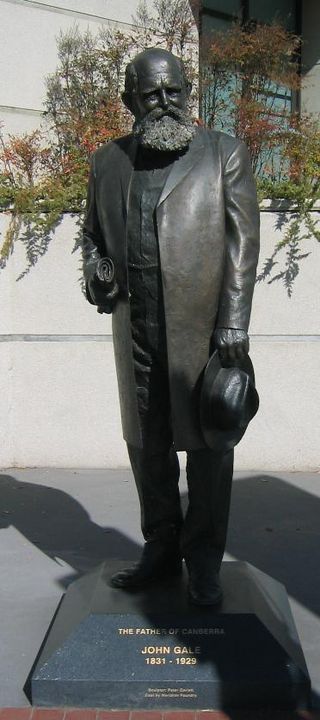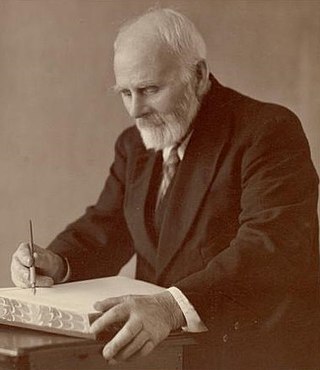
Queanbeyan is a city in the south-eastern region of New South Wales, Australia, located adjacent to the Australian Capital Territory in the Southern Tablelands region. Located on the Queanbeyan River, the city is the council seat of the Queanbeyan-Palerang Regional Council. At the 2021 census, the Queanbeyan part of the Canberra–Queanbeyan built-up area had a population of 37,511.

Braidwood is a town in the Southern Tablelands of New South Wales, Australia, in Queanbeyan–Palerang Regional Council. It is located on the Kings Highway linking Canberra with Batemans Bay. It is approximately 200 kilometres south west of Sydney, 60 kilometres inland from the coast, and 55 kilometres east of Canberra. Braidwood is a service town for the surrounding district which is based on sheep and cattle grazing, and forestry operations.

Sir Austin Chapman was an Australian politician who served in the House of Representatives from 1901 until his death in 1926. He held ministerial office in the governments of Alfred Deakin and Stanley Bruce, serving as Minister for Defence (1903–1904), Postmaster-General (1905–1907), Minister for Trade and Customs, and Minister for Health (1923–1924).

The Queanbeyan Age is a weekly newspaper based in Queanbeyan, New South Wales, Australia. It has had a number of title changes throughout its publication history. First published on 15 September 1860 by John Gale and his brother, Peter Francis Gale, The Golden Age, as it was known at the time, was the first newspaper of the small township on the banks of the Queanbeyan River. It was named due to the short-lived Kiandra goldrush, which generated large amounts of gold-based traffic through the region.

Weetangera is a suburb in the Belconnen district of Canberra, located within the Australian Capital Territory, Australia. The suburb covers an area of approximately 158 hectares. Located approximately 10 kilometres (6.2 mi) north-west of the city, Weetangera is bounded by Springvale Drive to the south and west, Coulter Drive to the east and Belconnen Way to the north. The Pinnacle Nature Reserve, a Canberra Nature Park is adjacent to the south of the suburb, across Springvale Drive.
Oaks Estate is a suburb in the district of Jerrabomberra, Canberra, Australian Capital Territory in Australia. Is situated on the northern side of the Australian Capital Territory and New South Wales border abutting the town of Queanbeyan in south-eastern New South Wales, Australia. The estate covers an area of approximately 40 hectares and is bound by the Molonglo River to the north, the Queanbeyan River to the east, 'The Oaks' to the west, and the Queanbeyan-Cooma railway to the south. Oaks Estate is located 12 kilometres from the centre of Canberra. The village is also noteworthy as the nucleus of Queanbeyan's industrial development during the second half of the 19th century. Oaks Estate takes its name from 'The Oaks', which was part of Duntroon, Robert Campbell's farming estate. This makes Oaks Estate one of only a few place names in the ACT with significant connections to early colonial times.

Tuggeranong Homestead is located in the Australian Capital Territory in the area now covered by the suburb of Richardson. It is a property of historical significance and is listed on the ACT Heritage Register. It was owned by a succession of prominent pastoralists over the last century before it was resumed by the Government. Today it is used as a venue for special events, conferences and weddings.

John Joseph Cusack was an Australian politician and businessman. He was a member of the Australian Labor Party (ALP) for most of his career and served in the New South Wales Legislative Assembly (1910–1917) and House of Representatives (1929–1931).

John Gale was an Australian newspaper proprietor, lay preacher and politician. He was the founder of The Queanbeyan Age, the first newspaper to serve the Queanbeyan district in New South Wales. He was also an advocate for the Queanbeyan-Canberra area as the best site of a future Australian national capital, for which he is sometimes called the "Father of Canberra". He served a single term as Member for Murrumbidgee in the New South Wales Legislative Assembly.

Samuel Shumack was an early Canberra pioneer and Australian farmer. He wrote his autobiography in the 1920s and it was published in 1967 as an account of rural living in the Canberra district.
The Canberra Region Rugby League competition is more commonly known as the Canberra Raiders Cup, covering the Australian Capital Territory and surrounding New South Wales towns Queanbeyan, Goulburn and Yass. The competition is run under the auspices of the Country Rugby League and players are eligible for selection in the Canberra Division of the CRL Tier 1 Divisional Championships. The Canberra district competition has an under 19s, reserve and first grade competitions.

The Roman Catholic Archdiocese of Canberra and Goulburn is a Latin Rite archdiocese located in the Australian Capital Territory, and the South West Slopes, Southern Tablelands, Monaro and the South Coast regions of New South Wales, Australia. Erected in 1948, the archdiocese is directly subject to the Holy See.

Blundells Cottage is a heritage-listed six-roomed stone cottage located on the northern shore of Lake Burley Griffin, in Canberra, Australia. The cottage was built by George P. Campbell in about 1858 for his ploughman William Ginn on the original Molonglo River floodplain. Ginn lived there with his family until 1874 and then Flora and George Blundell moved in and remained there until about 1933. Flora was a midwife and George a bullock driver for Campbell. In 1913 the Duntroon estate was acquired by the Commonwealth of Australia to form part of the new Federal Capital Territory, although the Blundells continued to live there. Then Harry and Alice Oldfield moved to the cottage in 1933.
Cuppacumbalong is an historic homestead located near the southern outskirts of Canberra in the Australian Capital Territory. It is also the name of a former 4,000-acre (16 km2) sheep and cattle grazing property that surrounded the homestead near the junction of the Murrumbidgee and Gudgenby Rivers. The word Cuppacumbalong is Aboriginal in origin and means 'meeting of the waters'. One of the property's early owners Leopold Fane De Salis made a noteworthy contribution to political life during colonial times and furthermore, Cuppacumbalong has strong connections to the life of William Farrer, the father of the Australian wheat industry.

Debden House is a residential adult education college, conference centre and campsite located in Loughton, Essex, England. The house is owned and operated by Newham London Borough Council.

Strathnairn Homestead in Strathnairn, Australian Capital Territory dates from the 1920s. It was acquired by the Baird family in 1934 who made major additions to the original house. The land was originally part of a grant awarded to explorer Captain Charles Sturt in 1838. The Baird family ran Strathnairn as a sheep and cattle property from 1934 until 1974 when it was resumed by the Commonwealth Government. It was first leased for community arts activities in 1977. Strathnairn Arts Centre continues to provide working spaces and facilities for artists, crafts people and community groups. It also has a café, shop and art gallery.

The Yarralumla Woolshed in the Australian Capital Territory is a building of historical significance and is listed on the Act Heritage Register. It is a symbol of Canberra's growth from pastoral town to major city. The shed was built in 1904 by Frederick Campbell who at that time owned Yarralumla Homestead which is now Government House. Today the woolshed is owned by the ACT Government and is an important community social centre and a venue for folk concerts, bush dances and is available for weddings.

The Ginninderra blacksmith’s shop is one of the most significant historical sites of the Australian Capital Territory. It was one of the first sites to be listed on the ACT Interim Heritage Places Register in 1993. The workshop is also of national importance as it is one of only a few known surviving stand-alone blacksmith shops in Australia; although, many farm-based smithies have survived. The building remains in stable condition, but there is no firm plan concerning its long-term management and it remains fenced-off and inaccessible to the public.
Queanbeyan, an electoral district of the Legislative Assembly in the Australian state of New South Wales was created in 1859 and abolished in 1913.
Lieutenant Colonel John Kenneth Mackenzie (1791–1857)—also spelt 'McKenzie' or 'MacKenzie'—was a military officer who fought in the Peninsula War and the War of 1812, and a pioneer colonial settler of New South Wales, Australia. He is a particularly associated with Nerriga, Braidwood and The Wool Road, but also with Dandelong, in the Monaro region.

















